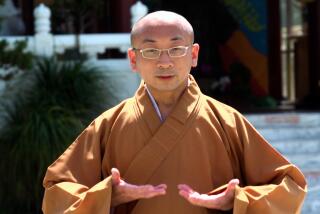China reopens Tibet to foreign tourists three months after violent riots
Tibet reopened to foreign tourists on Wednesday, three months after the Chinese government banned such visits in the wake of violent anti-government riots and protests that tainted the image of the country ahead of the Olympics.
The first foreign tourists, a retired Swedish couple, arrived at the airport near the capital, Lhasa, on Wednesday, said Tibetan Tourism Bureau spokesman Liao Lisheng.
“Tibet is open now to all travelers from home and abroad,” he said.
Kurt Persson, 77, and Eva Sandstrom, 62, were welcomed with traditional Tibetan white silk scarves at their hotel near the sacred Jokhang Temple, the official Xinhua News Agency said.
“We’ve been looking forward to visiting Tibet for many years. Its monasteries and landscapes are fascinating,” Xinhua quoted Sandstrom as saying.
Their five-day trip is their first to Tibet, Xinhua said. “We have no worries about the safety here,” she said. “The only worry was to get the permission to come to Tibet.”
The Himalayan region has been all but closed to the outside world since the biggest protests against Chinese rule in two decades exploded into rioting March 14 in Lhasa, leading Beijing to swiftly shut off the area.
Troops also flooded into predominantly Tibetan communities in nearby provinces, where sympathy demonstrations were occurring. They performed drills in town squares and set up checkpoints around sensitive areas. Officials said the restrictions were established for the safety of foreign tourists and journalists.
A notice on the tourism bureau’s Web site announcing the lifting of the ban said life in Lhasa had returned to normal.
“Tibet’s society is stable and harmonious, its markets bustling, and its environment beautiful,” it said.
But there are still signs of tension.
Buddhist monasteries seen as incubators for anti-government sentiment have been surrounded by security forces and closed off as searches were conducted and monks forced to undergo intensified political indoctrination against the Dalai Lama, Tibet’s exiled spiritual leader. Drepung, one of Lhasa’s main monasteries, remains shut.
Hundreds of alleged perpetrators have also been arrested in the last three months, with many sentenced to years or life in prison in short trials for their role in the protests.
Last week’s Olympic torch run through Lhasa was carefully orchestrated after it was cut to one day from the original three. Crowds were monitored by security agents and only a few hand-picked foreign journalists, who even under ordinary conditions must apply for special permission to visit Tibet, were invited to cover the event.
The three-hour relay was apparently completed without incident.
It had been considered a flashpoint amid criticism by overseas Tibetan activist groups who accuse Beijing of using the event to symbolize its control over the region. China says it has ruled Tibet for centuries, although many Tibetans say their homeland was essentially independent for much of that time.
Chen Ziyong, general manager of the Lhasa-based Shigatse International Travel Agency, said the Swedes will be followed by four Singaporeans on Sunday.
The rules for foreign travel to Tibet will not change, said Liao, the tourism bureau spokesman. Foreigners still have to get an extra permit for the region through an official travel agency and are not allowed to move around without a tourist guide, he said.
“If they don’t have a purpose like separating the country or trying to cause damage, then the foreign tourists can have an entry permit,” he said.
Despite the lifting of the ban, it’s still not clear how accessible Tibet really is, given that foreign visas to China are being restricted in the run-up to the Aug. 8 Beijing Olympics, said Michael C. Davis, a law professor and China expert at Hong Kong’s City University.
“In name they could lift the restrictions but still have them across the board because in the past each case was decided individually,” he said.
Foreign journalists also remain restricted. Foreign Ministry spokesman Liu Jianchao told reporters at a regular news briefing Tuesday that China will continue to work to further stabilize the situation in Tibet and would help foreign journalists go there “at an early date.”
The March violence and the subsequent tourist ban have taken a major toll on Lhasa’s economy, which has become increasingly reliant on tourism since the start of rail service nearly two years ago.
Hotels in Lhasa said they’d had almost no customers since the unrest.
“We’ve had zero business since the Lhasa rioting, not even a penny,” said Ms. Deji, manager of booking at Hotel Kyichu in downtown Lhasa. She refused to give her full name, as possible sign of continuing nervousness over being identified by authorities as a troublemaker.
Deji said it will take at least three years for business to return to normal, and that half her employees had changed jobs or stayed home since March.
Tibet had 4 million visitors in 2007, up 60 percent from the previous year, Xinhua reported earlier this year. Tourism revenues hit US$687 million, accounting for more than 14 percent of the economy.
Chinese domestic visitors were allowed back into Tibet in late April, and more than 160 groups have so far traveled there, the Tibetan Tourism Bureau said.
But the general manager of Tibet Shambhala Travel Agency in Beijing said many people are still too scared to make the trip.
“We predict that we won’t have any business until October,” said Ms. Chen, who also would not give her first name.
China says 22 people died in the anti-government protests. But overseas Tibet supporters say many times that number were killed in the riots and the resulting security crackdown.
More to Read
Sign up for The Wild
We’ll help you find the best places to hike, bike and run, as well as the perfect silent spots for meditation and yoga.
You may occasionally receive promotional content from the Los Angeles Times.






